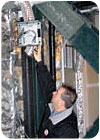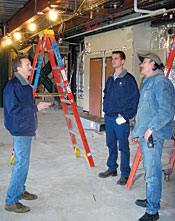
DETROIT - Major League Baseball appeared to open without a hitch as President George W. Bush tossed out the traditional first ball in Cincinnati. However, behind the scenes in ballparks all around the country, HVAC service contractors were frantically working to ensure that mechanical systems were ready for opening day. In some instances, major renovation was required before the first player could tear around the base path.
One such place was Comerica Park. The "Roar of '84" will be evident again in Detroit, a flashback to the year the Detroit Tigers last won a world championship. The baseball club decided to eliminate nine private luxury suites and combine them all into a new "Champions Club" with a bar and indoor/outdoor seating for up to 114 people.
One of the showpieces in the new club will be the 1984 World Series trophy, along with the 1968 World Series trophy. Tiger owner Mike Ilitch asked his staff to have the area ready for Opening Day 2006, which meant that a lot of work had to go into the redesign of the existing space, including the mechanical equipment - and in a very short period of time.
The task presented a challenge to Allan Carisse, manager of the Comerica Park HVAC department. "We basically had to redraw, rewire, replumb, repipe, and give the area a new brain," he said.
MAKING THE SWITCH
The existing nine private suites were heated and cooled by 2 1/2 ton heat pumps located above the ceiling in each suite bathroom. Eliminating the bathroom and attached ductwork would have to come soon after the walls were torn out. The "brains" would also have to be reworked, which were the individual room controls.Carisse performed load calculations for the new space and determined that 20 tons of cooling would be required, which would eliminate the need for two of the nine heat pumps. In the old configuration with the heat pumps above the bathroom ceiling tiles, accessibility for service was challenging. The relocated units would be easily accessible and can be removed in a fairly straightforward manner using a mechanical lift and one person.
The attached ductwork also needed to be resized and fitted. All of the mechanical equipment needed to be positioned as close to the ceiling as possible, so as not to be obtrusive. All of the equipment was to remain exposed and sprayed the same color to fit the new scheme. The units were to be "hidden in plain sight." Carisse said, "aesthetics are number one when it comes to a job like this."
Since the units were positioned so close to the ceiling, access for maintenance, such as filter changes, had to be taken into account. Each unit had to be mounted with drop-down mounting rods in order to access the filter compartment, the motor, etc.
Some of the piping for the plumbing and sprinkler system needed to be moved, too. Even some of the temporary stadium support beams had to be removed. But that's OK - using the same equipment, even despite a lot of alteration, saves money. "We had to keep costs down," Carisse said.
"This is one retrofit project that is cost-driven."
The one unknown that was a concern to Carisse is how much the entry doors would be opened and closed during use. If the doors remain open, he may have to readjust his load calculations. But he won't know for sure until the Tigers start playing and the crowds fill up the Champions Club.

JOB CHALLENGES MADE EASIER
Joseph Septak, owner of U.S. Refrigeration Inc. of Detroit, the contractor who worked on the retrofit project, said the job was difficult because there were no mechanical blueprints to work off of. "Every step of the way we had to get approval to do things, like move a pipe, because there were no mechanical specifications," he said."We knew that air distribution was going to be a problem right off the bat. The ceilings are relatively low and we didn't want to have air blowing down on people sitting along the window of the Club."
Fortunately, Septak's crew had easy access to the jobsite despite the unique atmosphere surrounding Comerica Park. A lot of the work was performed while security was heightened for Super Bowl XL, which was played at Ford Field, the Detroit Lions' stadium directly across the street from Comerica Park.
"Accessibility was easy," he said. "We were able to get through security and to the jobsite right away. Alan made sure that the barricades were moved to allow us to get in and out. We were also able to work with the electricians and coordinate with their schedules."

Septak said that because of the tight spots, it was more difficult to get to some of the main access points. "ProPress is a labor-saving way and this was very valuable based on the accelerated time schedule to complete the work before Opening Day," he said.
"We blew through a lot of fittings that had no leaks whatsoever. We didn't have to go back on even one connection."
Septak also credits workers from Ronfab Inc., Detroit, for spending countless hours fabricating sheet metal for the relocated heat pumps. "They made our job a lot easier, too," he said.
Carisse said he expects to work out any bugs in the Champions Club as the early season progresses. He would like to relocate the temperature sensors from their hidden, hard-to-reach location in the support beams. But he knows that the park managers want to keep the aesthetics and not expose any unpainted mechanical equipment. "We'll see about painting the sensors, too," Carisse added.
He noted that all of the air-handling units are tied into the fire alarm system and will immediately shut down when the alarm is activated. That is something that can be done without the human touch via the controls system. But what can be done with the human touch will be some system tweaking.
"This is a work in progress," he said. "As we get more visitors, we will be able to set the controls to maximize comfort for any number of people in the club."
Publication date: 04/24/2006

Report Abusive Comment